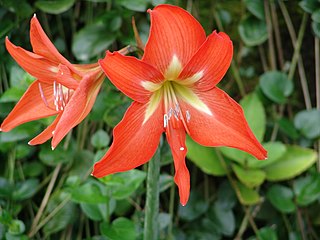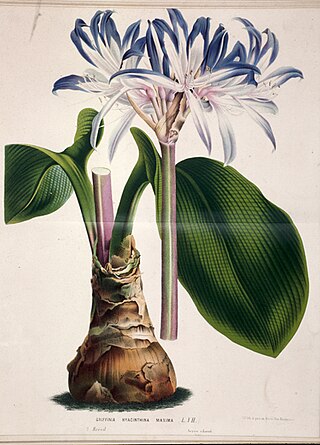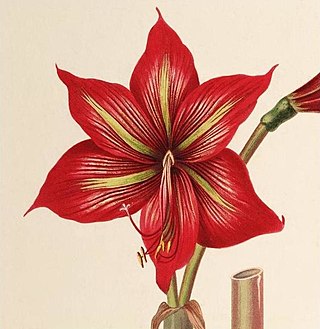
Amaryllis is the only genus in the subtribe Amaryllidinae. It is a small genus of flowering bulbs, with two species. The better known of the two, Amaryllis belladonna, is a native of the Western Cape region of South Africa, particularly the rocky southwest area between the Olifants River Valley and Knysna.

Hippeastrum is a genus of about 90 species, and over 600 hybrids and cultivars, of perennial, herbaceous and bulbous plants, native to tropical and subtropical regions of the Americas, from Mexico south to Argentina and on some islands in the Caribbean. The majority have large, fleshy bulbs—usually about the size of a softball—and tall, broad, strap-like leaves that are (generally) evergreen, and large red or purple flowers. Numerous colors and cultivars have been created over the past hundred years.

Griffinia hyacinthina is a bulbous species of flowering plant which is endemic to Brazil.

Lilium pensylvanicum is an Asian plant species of the family Liliaceae. Sometimes called the Siberian lily, it is native to a cold climate and needs frost in the winter. It is found in the wild form in Siberia, the Russian Far East, Mongolia, northeast China, Korea and Hokkaidō.

Hippeastrum aulicum, the Lily of the Palace, is a bulbous perennial, in the family Amaryllidaceae, native to the Atlantic Forest and Cerrado ecoregions from Brazil to Paraguay, in South America.

Hippeastrum calyptratum is a flowering perennial herbaceous bulbous plant, in the family Amaryllidaceae, native to Brazil.

Hippeastrum correiense is a flowering perennial herbaceous bulbous plant, in the family Amaryllidaceae, native to Brazil.

Hippeastrum cybister is a flowering perennial herbaceous bulbous plant, in the family Amaryllidaceae, native from Bolivia to Argentina.

Hippeastrum miniatum is a flowering perennial herbaceous bulbous plant, in the family Amaryllidaceae, native to Peru.

Hymenocallis tubiflora is a plant species from Trinidad and northern South America. It is reported from Trinidad, Venezuela, Guyana, Suriname, French Guiana, and northern Brazil. The name was originally coined in 1812, the description based on a specimen grown at Kew Botanical Garden in London, the bulb having been seized by British sailors from a French ship captured by the Royal Navy in 1803.

Hippeastrum papilio is a flowering perennial herbaceous bulbous plant, in the family Amaryllidaceae, native to southern Brasil.

Hippeastrum pardinum is a flowering perennial herbaceous bulbous plant, in the family Amaryllidaceae, from Peru to Bolivia. Originally collected in 1866 by Richard Pearce, it was used in breeding programmes.
Hippeastrum petiolatum is a flowering perennial herbaceous bulbous plant, in the family Amaryllidaceae, distributed from Paraguay to Uruguay and Argentina.

Hippeastrum reginae is a flowering perennial herbaceous bulbous plant, in the family Amaryllidaceae, native to Venezuela, Bolivia, Peru and Brazil.

Gunnera magellanica is a perennial rhizomatous dioeceous herb native to Chile, Argentina and the Falkland Islands, and Andean areas of Peru, Ecuador. In the southern part of its range it grows in damper parts of the Magellanic subpolar forests and Valdivian temperate forests, and shrub formations on Tierra del Fuego, with an altitudinal range from sea level to 1500m.

Hippeastrum striatum, the striped Barbados lily, a flowering perennial herbaceous bulbous plant, in the family Amaryllidaceae, native to the southern and eastern regions of Brazil.

Hippeastrum mirum is a species of herbaceous perennial bulbous flowering plants in the amaryllis family, Amaryllidaceae, subfamily Amaryllidoideae. It was formerly treated as Tocantinia mira.

Hippeastrum reticulatum, the netted-veined amaryllis, is a flowering perennial herbaceous bulbous plant, in the family Amaryllidaceae, native to South America.

Dr. Charlotte M. Taylor is a botanist and professor specialising in taxonomy and conservation. She works with the large plant family Rubiaceae, particularly found in the American tropics and in the tribes Palicoureeae and Psychotrieae. This plant family is an economically important group, as it includes plant species used to make coffee and quinine. Taylor also conducts work related to the floristics of Rubiaceae and morphological radiations of the group. Taylor has collected plant samples from many countries across the globe, including Chile, Colombia, Costa Rica, Panama, and the United States of America, and has named many new species known to science from these regions. As of 2023, Taylor has authored 500 land plant species' names, the third-highest number of such names authored by any female scientist.



















